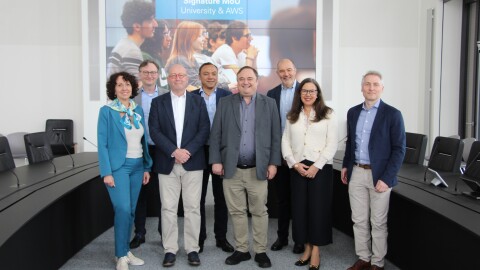As customer demand continues to grow, including for generative AI and machine learning services, Amazon Web Services (AWS) is investing to support their needs by expanding its data centre capacity. In the Europe (Stockholm) Region, it is currently building new data centres in three Availability Zones located in Eskilstuna, Katrineholm and Västerås. The main buildings are due for completion by mid-2025.
AWS is working with our supply chain to use lower-carbon concrete, steel, and other materials whenever possible. The construction industry is one of the largest and toughest sectors to decarbonize; embodied carbon—the emissions released during building materials’ life cycle, from extraction to manufacturing, transport, and construction to disposal—accounts for around 11% of global carbon emissions.
Sourcing lower carbon recycled steel for all our new data centres in Mälardalen
Roughly 70% of steel worldwide is made from iron ore via the blast furnace to basic oxygen furnace (BF-BOF) route which burns coal. Iron ore is melted and reduced to make iron in a blast furnace – and then the iron is converted into steel in a basic oxygen furnace. Coal and coke, a product made from coal, are responsible for the majority of steel’s CO₂ emissions.
Globally, AWS strives to use steel made by recycling scrap in electric arc furnaces (EAF). Roughly 30% of steel worldwide is made via this route, which doesn’t use coal or coke. Electricity is used instead – and often a small amount of natural gas. As a result, the scrap-EAF steel route has one-quarter of the carbon emissions associated with BF-BOF steel making. AWS has worked with our supply chain to ensure that at least 70% of structural steel used in our Eskilstuna and Västerås data centres will come from the scrap-EAF route, resulting in 10,000 fewer tonnes of embodied carbon emissions for our business.

For our data centre in Katrineholm, AWS has gone one step further. All the structural open steel sections will be produced from scrap melted in electric arc furnaces powered by 100% carbon-free electricity, with minimal (if any) use of natural gas. This results in one-seventh of the carbon emissions compared with BF-BOF steel making. This will result in our Katerineholm data centre excpected to contribute 5900 fewer tonnes of carbon to AWS’s emissions footprint than it otherwise would have.
Importantly though, scrap-EAF steel production is limited by how much waste steel and iron the world creates. The International Energy Agency forecasts there will only be enough steel scrap generated in 2050 to meet 45% of global demand. The world therefore needs to develop and rapidly deploy low-carbon technologies to make ‘primary’ or ‘virgin’ steel from iron ore.
Finding new sources of lower carbon primary steel for our data centres
In pursuit of new sources of lower carbon primary steel, AWS has teamed up with SSAB and its subsidiary, Ruukki Construction.

SSAB has together with iron ore company LKAB and energy company Vattenfall developed a new technology called HYBRIT (short for Hydrogen Breakthrough Ironmaking Technology) that uses hydrogen, made from carbon-free electricity, to make iron. This process emits water vapor instead of carbon dioxide. An Electric Arc Furnace (which is powered by carbon-free electricity) is then used to convert the iron to steel. This results in primary steel with one-tenth of the carbon emissions of conventional BF-BOF steelmaking. Steel from this innovative process will be used in AWS’s new data centre in Västerås.
“Reducing the embodied carbon associated with the construction of our data centers is a key priority for AWS as we work to achieve net-zero carbon across our operations by 2040. By partnering with innovative local companies like SSAB and Ruukki, we’re taking an important step to decarbonise the materials used in our data centres and set a new standard for sustainable infrastructure. We’re excited to be working with companies at the forefront of lower-carbon virgin steel production,” said Kellen O’Connor, Managing Director Europe North at AWS.
AWS is procuring low carbon primary steel that SSAB has made available from the HYBRIT pilot facility in Luleå, before production volumes increase. In a world-first for the data centre industry, the steel is being used in panels to clad the façade of a new data centre.

“We are thrilled to welcome AWS as a new partner. By choosing steel made with the HYBRIT technology, AWS shows it’s possible to reduce the carbon footprint of data centre construction regardless of whether the steel is made from scrap or virgin iron ore,” said Thomas Hörnfeldt, VP of Sustainable Business at SSAB.
"This is an exciting project that shows how well our solutions fit into the data centre segment. It is also a great example of how we, together with customers like AWS, can make construction more sustainable. SSAB Fossil-free™ steel and Ruukki® LowCarbon offerings are at the forefront in reducing emissions of construction," said Per Göransson, Business Director, Building Envelopes, Scandinavia, Ruukki Construction.












